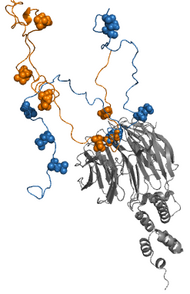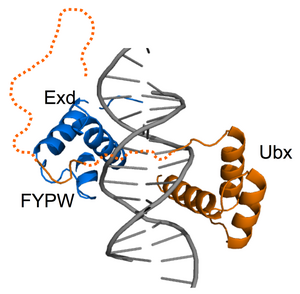Biology:Fuzzy complex


Fuzzy complexes are protein complexes, where structural ambiguity or multiplicity exists and is required for biological function.[1][2] Alteration, truncation or removal of conformationally ambiguous regions impacts the activity of the corresponding complex.[3][4][5] Fuzzy complexes are generally formed by intrinsically disordered proteins.[6][7] Structural multiplicity usually underlies functional multiplicity of protein complexes [8][9][10] following a fuzzy logic. Distinct binding modes of the nucleosome are also regarded as a special case of fuzziness.[11][12]
Historical background
For almost 50 years molecular biology was based on two dogmas: (i) equating biological function of the protein with a unique three-dimensional structure and (ii) assuming exquisite specificity in protein complexes. Specificity/selectivity is ensured by unambiguous set of interactions formed between the protein and its ligand (another protein, DNA, RNA or small molecule). Many protein complexes however, contain functionally important/critical regions, which remain highly dynamic in the complex or adopt different conformations.[13] This phenomenon is defined fuzziness. The most pertinent example is the cyclin-dependent kinase inhibitor Sic1, which binds to the SCF subunit of Cdc4 in a phosphorylation dependent manner.[14] No regular secondary structures are gained upon phosphorylation and the different phosphorylation sites interchange in the complex.[15]
Classification of fuzzy complexes
Structural ambiguity in protein complexes covers a wide spectrum.[1] In a polymorphic complex, the protein adopts two or more different conformations upon binding to the same partner, and these conformations can be resolved.[16] Clamp,[17] flanking [18][19] and random complexes[20][21] are dynamic, where ambiguous conformations interchange with each other and cannot be resolved. Interactions in fuzzy complexes are usually mediated by short motifs.[22] Flanking regions are tolerant to sequence changes as long as the amino acid composition is maintained, for example in case of linker histone C-terminal domains [23] and H4 histone N-terminal domains.[24]
Regulatory pathways via fuzzy regions
Fuzzy regions modulate the conformational equilibrium [25] or flexibility [3][26] of the binding interface via transient interactions.[27] Dynamic regions can also compete with binding sites[28] or tether them to the target.[29] Modifications of fuzzy regions by further interactions,[8][30] or posttranslational modifications[31][32] impact binding affinity or specificity. Alternative splicing can modulate the length of fuzzy regions resulting in context-dependent binding (e.g. tissue-specificity) on the complex.[33][34][35] EGF/MAPK, TGF-β and WNT/Wingless signaling pathways employ tissue-specific fuzzy regions.
References
- ↑ 1.0 1.1 Tompa, Peter; Fuxreiter, Monika (2008). "Fuzzy complexes: Polymorphism and structural disorder in protein–protein interactions". Trends in Biochemical Sciences 33 (1): 2–8. doi:10.1016/j.tibs.2007.10.003. PMID 18054235.
- ↑ Fuxreiter, M. & Tompa, P. (2011) Fuzziness: Structural Disorder in Protein Complexes Austin, New York.[page needed]
- ↑ 3.0 3.1 Pufall, M. A; Lee, Gregory M; Nelson, Mary L; Kang, Hyun-Seo; Velyvis, Algirdas; Kay, Lewis E; McIntosh, Lawrence P; Graves, Barbara J (2005). "Variable Control of Ets-1 DNA Binding by Multiple Phosphates in an Unstructured Region". Science 309 (5731): 142–5. doi:10.1126/science.1111915. PMID 15994560. Bibcode: 2005Sci...309..142P.
- ↑ Bhattacharyya, R. P; Reményi, Attila; Good, Matthew C; Bashor, Caleb J; Falick, Arnold M; Lim, Wendell A (2006). "The Ste5 Scaffold Allosterically Modulates Signaling Output of the Yeast Mating Pathway". Science 311 (5762): 822–6. doi:10.1126/science.1120941. PMID 16424299. Bibcode: 2006Sci...311..822B.
- ↑ Liu, Ying; Matthews, Kathleen S; Bondos, Sarah E (2009). "Internal Regulatory Interactions Determine DNA Binding Specificity by a Hox Transcription Factor". Journal of Molecular Biology 390 (4): 760–74. doi:10.1016/j.jmb.2009.05.059. PMID 19481089.
- ↑ Romero, P; Obradovic, Z; Kissinger, C. R; Villafranca, J. E; Garner, E; Guilliot, S; Dunker, A. K (1998). "Thousands of proteins likely to have long disordered regions". Pacific Symposium on Biocomputing: 437–48. PMID 9697202. http://psb.stanford.edu/psb-online/proceedings/psb98/abstracts/p437.html.
- ↑ Wright, Peter E; Dyson, H. Jane (1999). "Intrinsically unstructured proteins: Re-assessing the protein structure-function paradigm". Journal of Molecular Biology 293 (2): 321–31. doi:10.1006/jmbi.1999.3110. PMID 10550212.
- ↑ 8.0 8.1 Galea, Charles A; Nourse, Amanda; Wang, Yuefeng; Sivakolundu, Sivashankar G; Heller, William T; Kriwacki, Richard W (2008). "Role of Intrinsic Flexibility in Signal Transduction Mediated by the Cell Cycle Regulator, p27Kip1". Journal of Molecular Biology 376 (3): 827–38. doi:10.1016/j.jmb.2007.12.016. PMID 18177895.
- ↑ Fuxreiter, Monika; Tompa, Peter; Simon, István; Uversky, Vladimir N; Hansen, Jeffrey C; Asturias, Francisco J (2008). "Malleable machines take shape in eukaryotic transcriptional regulation". Nature Chemical Biology 4 (12): 728–37. doi:10.1038/nchembio.127. PMID 19008886.
- ↑ Wang, Yuefeng; Fisher, John C; Mathew, Rose; Ou, Li; Otieno, Steve; Sublet, Jack; Xiao, Limin; Chen, Jianhan et al. (2011). "Intrinsic disorder mediates the diverse regulatory functions of the Cdk inhibitor p21". Nature Chemical Biology 7 (4): 214–21. doi:10.1038/nchembio.536. PMID 21358637.
- ↑ Belch, Yaakov; Yang, Jingyi; Liu, Yang; Malkaram, Sridhar A; Liu, Rong; Riethoven, Jean-Jack M; Ladunga, Istvan (2010). "Weakly Positioned Nucleosomes Enhance the Transcriptional Competency of Chromatin". PLOS ONE 5 (9): e12984. doi:10.1371/journal.pone.0012984. PMID 20886052. Bibcode: 2010PLoSO...512984B.
- ↑ Tsui, K; Dubuis, S; Gebbia, M; Morse, R. H; Barkai, N; Tirosh, I; Nislow, C (2011). "Evolution of Nucleosome Occupancy: Conservation of Global Properties and Divergence of Gene-Specific Patterns". Molecular and Cellular Biology 31 (21): 4348–55. doi:10.1128/MCB.05276-11. PMID 21896781.
- ↑ Fuxreiter, Monika (2012). "Fuzziness: Linking regulation to protein dynamics". Molecular BioSystems 8 (1): 168–77. doi:10.1039/c1mb05234a. PMID 21927770.
- ↑ Nash, Piers; Tang, Xiaojing; Orlicky, Stephen; Chen, Qinghua; Gertler, Frank B; Mendenhall, Michael D; Sicheri, Frank; Pawson, Tony et al. (2001). "Multisite phosphorylation of a CDK inhibitor sets a threshold for the onset of DNA replication". Nature 414 (6863): 514–21. doi:10.1038/35107009. PMID 11734846. Bibcode: 2001Natur.414..514N.
- ↑ Mittag, T; Orlicky, S; Choy, W.-Y; Tang, X; Lin, H; Sicheri, F; Kay, L. E; Tyers, M et al. (2008). "Dynamic equilibrium engagement of a polyvalent ligand with a single-site receptor". Proceedings of the National Academy of Sciences 105 (46): 17772–7. doi:10.1073/pnas.0809222105. PMID 19008353. Bibcode: 2008PNAS..10517772M.
- ↑ Didry, Dominique; Cantrelle, Francois-Xavier; Husson, Clotilde; Roblin, Pierre; Moorthy, Anna M Eswara; Perez, Javier; Le Clainche, Christophe; Hertzog, Maud et al. (2012). "How a single residue in individual β-thymosin/WH2 domains controls their functions in actin assembly". The EMBO Journal 31 (4): 1000–13. doi:10.1038/emboj.2011.461. PMID 22193718.
- ↑ Fontes, Marcos R.M; Teh, Trazel; Kobe, Bostjan (2000). "Structural basis of recognition of monopartite and bipartite nuclear localization sequences by mammalian importin-α". Journal of Molecular Biology 297 (5): 1183–94. doi:10.1006/jmbi.2000.3642. PMID 10764582.
- ↑ Zor, Tsaffrir; Mayr, Bernhard M; Dyson, H. Jane; Montminy, Marc R; Wright, Peter E (2002). "Roles of Phosphorylation and Helix Propensity in the Binding of the KIX Domain of CREB-binding Protein by Constitutive (c-Myb) and Inducible (CREB) Activators". Journal of Biological Chemistry 277 (44): 42241–8. doi:10.1074/jbc.M207361200. PMID 12196545.
- ↑ Selenko, Philipp; Gregorovic, Goran; Sprangers, Remco; Stier, Gunter; Rhani, Zakaria; Krämer, Angela; Sattler, Michael (2003). "Structural Basis for the Molecular Recognition between Human Splicing Factors U2AF65 and SF1/mBBP". Molecular Cell 11 (4): 965–76. doi:10.1016/S1097-2765(03)00115-1. PMID 12718882.
- ↑ Pometun, Maxim S; Chekmenev, Eduard Y; Wittebort, Richard J (2004). "Quantitative Observation of Backbone Disorder in Native Elastin". Journal of Biological Chemistry 279 (9): 7982–7. doi:10.1074/jbc.M310948200. PMID 14625282.
- ↑ Sigalov, Alexander; Aivazian, Dikran; Stern, Lawrence (2004). "Homooligomerization of the Cytoplasmic Domain of the T Cell Receptor ζ Chain and of Other Proteins Containing the Immunoreceptor Tyrosine-Based Activation Motif". Biochemistry 43 (7): 2049–61. doi:10.1021/bi035900h. PMID 14967045.
- ↑ Davey, Norman E; Travé, Gilles; Gibson, Toby J (2011). "How viruses hijack cell regulation". Trends in Biochemical Sciences 36 (3): 159–69. doi:10.1016/j.tibs.2010.10.002. PMID 21146412.
- ↑ Lu, Xu; Hamkalo, Barbara; Parseghian, Missag H; Hansen, Jeffrey C (2009). "Chromatin Condensing Functions of the Linker Histone C-Terminal Domain Are Mediated by Specific Amino Acid Composition and Intrinsic Protein Disorder". Biochemistry 48 (1): 164–72. doi:10.1021/bi801636y. PMID 19072710.
- ↑ McBryant, Steven J; Klonoski, Joshua; Sorensen, Troy C; Norskog, Sarah S; Williams, Sere; Resch, Michael G; Toombs, James A; Hobdey, Sarah E et al. (2009). "Determinants of Histone H4 N-terminal Domain Function during Nucleosomal Array Oligomerization". Journal of Biological Chemistry 284 (25): 16716–22. doi:10.1074/jbc.M109.011288. PMID 19395382.
- ↑ Naud, Jean-François; McDuff, François-Olivier; Sauvé, Simon; Montagne, Martin; Webb, Bradley A; Smith, Steven P; Chabot, Benoit; Lavigne, Pierre (2005). "Structural and Thermodynamical Characterization of the Complete p21 Gene Product of Max". Biochemistry 44 (38): 12746–58. doi:10.1021/bi0500729. PMID 16171389.
- ↑ Lee, Gregory M; Pufall, Miles A; Meeker, Charles A; Kang, Hyun-Seo; Graves, Barbara J; McIntosh, Lawrence P (2008). "The Affinity of Ets-1 for DNA is Modulated by Phosphorylation Through Transient Interactions of an Unstructured Region". Journal of Molecular Biology 382 (4): 1014–30. doi:10.1016/j.jmb.2008.07.064. PMID 18692067.
- ↑ Fuxreiter, Monika; Simon, Istvan; Bondos, Sarah (2011). "Dynamic protein–DNA recognition: Beyond what can be seen". Trends in Biochemical Sciences 36 (8): 415–23. doi:10.1016/j.tibs.2011.04.006. PMID 21620710.
- ↑ Watson, Matthew; Stott, Katherine; Thomas, Jean O (2007). "Mapping Intramolecular Interactions between Domains in HMGB1 using a Tail-truncation Approach". Journal of Molecular Biology 374 (5): 1286–97. doi:10.1016/j.jmb.2007.09.075. PMID 17988686.
- ↑ Olson, Katie E; Narayanaswami, Pranesh; Vise, Pamela D; Lowry, David F; Wold, Marc S; Daughdrill, Gary W (2005). "Secondary Structure and Dynamics of an Intrinsically Unstructured Linker Domain". Journal of Biomolecular Structure and Dynamics 23 (2): 113–24. doi:10.1080/07391102.2005.10507052. PMID 16060685.
- ↑ Ahmed, Mumdooh A.M; Bamm, Vladimir V; Shi, Lichi; Steiner-Mosonyi, Marta; Dawson, John F; Brown, Leonid; Harauz, George; Ladizhansky, Vladimir (2009). "Induced Secondary Structure and Polymorphism in an Intrinsically Disordered Structural Linker of the CNS: Solid-State NMR and FTIR Spectroscopy of Myelin Basic Protein Bound to Actin". Biophysical Journal 96 (1): 180–91. doi:10.1016/j.bpj.2008.10.003. PMID 19134474. Bibcode: 2009BpJ....96..180A.
- ↑ Jonker, Hendrik R. A; Wechselberger, Rainer W; Pinkse, Martijn; Kaptein, Robert; Folkers, Gert E (2006). "Gradual phosphorylation regulates PC4 coactivator function". FEBS Journal 273 (7): 1430–44. doi:10.1111/j.1742-4658.2006.05165.x. PMID 16689930.
- ↑ Tsunaka, Yasuo; Toga, Junko; Yamaguchi, Hiroto; Tate, Shin-Ichi; Hirose, Susumu; Morikawa, Kosuke (2009). "Phosphorylated Intrinsically Disordered Region of FACT Masks Its Nucleosomal DNA Binding Elements". Journal of Biological Chemistry 284 (36): 24610–21. doi:10.1074/jbc.M109.001958. PMID 19605348.
- ↑ Tanaka, Tomoaki; Kawashima, Hidenori; Yeh, Edward T. H; Kamitani, Tetsu (2003). "Regulation of the NEDD8 Conjugation System by a Splicing Variant, NUB1L". Journal of Biological Chemistry 278 (35): 32905–13. doi:10.1074/jbc.M212057200. PMID 12816948.
- ↑ Liu, Ying; Matthews, Kathleen S; Bondos, Sarah E (2008). "Multiple Intrinsically Disordered Sequences Alter DNA Binding by the Homeodomain of the Drosophila Hox Protein Ultrabithorax". Journal of Biological Chemistry 283 (30): 20874–87. doi:10.1074/jbc.M800375200. PMID 18508761.
- ↑ Brayer, K. J; Lynch, V. J; Wagner, G. P (2011). "Evolution of a derived protein-protein interaction between HoxA11 and Foxo1a in mammals caused by changes in intramolecular regulation". Proceedings of the National Academy of Sciences 108 (32): E414–20. doi:10.1073/pnas.1100990108. PMID 21788518. Bibcode: 2011PNAS..108E.414B.
 |

